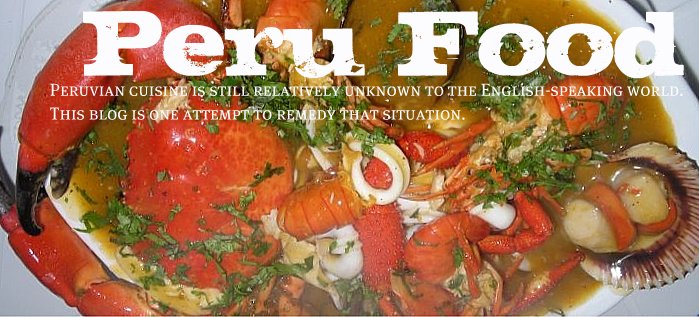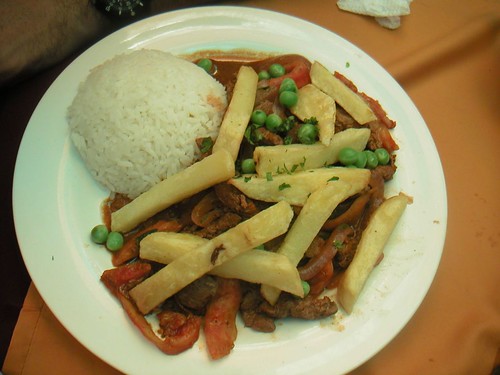
One of the wonderful things about a city with such a long history as Lima is the fact there are any number of places where you feel you have stepped back in time and escaped the hustle and bustle of the modern metropolis.
Antigua Taberna Queirolo, in the Pueblo Libre district, is such a place.
Founded in 1880 by an Italian immigrant to Peru, Santiago Queirolo Raggio, the Antigua Taberna Queirolo is a historic locale evocative of a long-ago era. When it was originally opened, this part of the city (then called Pueblo de Magdalena or Magdalena Vieja) was an agricultural region known for its pleasant climate and fertile land. Santiago Queirolo, who owned grape vineyards near Cañete south of Lima, first opened a pulpería, which specialized in octopus, next to his bodega (warehouse) where he began selling his pisco and wine to the local owners of the haciendas and their workers.

Over time, his small business flourished and now the Santiago Queirolo brand is one of the most well-known and highly-regarded wine and pisco producers in Peru.
The Antigua Taberna Queirolo is believed to be one of the oldest restaurants in Peru; as you walk in, you immediately notice many of the details have not changed over the hundred-plus years it has been open. This is one of those places where people come over a lifetime to eat, drink, and spend long afternoons lost in conversation.

The Antigua Taberna Queirolo is minutes from busy avenues replete with cars and buses; yet, because it is in Pueblo Libre's historic core, it feels like a small town.
The surrounding area is worth a stroll, and one of Peru's oldest museums is just across the street, the National Museum of Archeology, Anthropology and History of Peru.
Our visit was just for appetizers since we were en route for lunch at another great local restaurant just around the corner called El Bolivariano, which I'll write about in a later post.

The roast pork Peruvian-style sandwiches are famous at the Antigua Taberna Queirolo, but we opted for a serving of cau cau limeño which is made from beef tripe and potatoes. Not something for everyone's palate, but delicious if you dare to eat it.
The dishes are listed on a chalkboard, and you can also see what you wish to order as many of the dishes are in full view of the patrons behind an ancient glass counter. This is not an elegant place so don't expect five-star service. In fact, the waiters are somewhat known for sometimes being gruff, but if you have patience, a good dose of humor, and an adventurous culinary heart, you won't have any problems. It's all part of Antigua Taberna Queirolo's charm.

We also had an order of one of my favorite seafood dishes, choros a la chalaca, which are mussels topped with onions, tomatoes, and spicy Peruvian ají. We got so excited by them we had gobbled down almost the entire dozen before I realized we hadn't taken a picture, which is why the photo above has only two choros left. They are very tasty.

Of course, we washed down our food with a pisco sour and a chicha morada, the sweet purple corn drink. If you are interested in drinking heartily, you can order a res completo, literally a 'whole cow' (below is the explanation of the term). Instead of a side of beef, you get a bottle of pisco, another of 7 Up or Canada Dry, a plate of sliced limes and a bucket of ice. It doesn't get better than that for a long and animated discussion of Peruvian politics or sports, which seem to be what many of the old-timers in the place were doing.
In doing research for this post, I also came across a short video of Gastón Acurio's program, Aventura Culinaria (Culinary Adventure), which ran on Peruvian television. The video is in Spanish but it has great shots of the Antigua Taberna Queirolo, including historical photos that illustrate its development over time. I liked it so much I went ahead and translated the dialogue into English. The video is only 2:16 minutes long and I recommend you watch it. My translation appears below (and it explains the origin of the word res for the pisco and soda drink). The end of the video shows the famous roast pork sandwiches.
Gastón: In this adventure, we are going to show you that good restaurants never go out of style. Good restaurants stand the test of time, they improve, they grow, and they become part of the city's fabric. To begin this story, it is only logical we seek the oldest restaurant in Peru. What is it? The Queirolo. Imagine, a hundred and some years ago in a city in which there were only small fondas, where food was mostly sold on the street, all of a sudden this place appeared, this place which is so magical, and even better than it was originally.
Gastón: In what year was La Taberna founded?
Queirolo Staff: La Taberna was founded in 1880. More or less the same year the Queirolo family arrived here in Magdelena Viejo. They chose this corner, where they first opened a pulpería which sold octopus, because there was a streetcar pulled by horses that would go as far as Avenida Brasil, where there was another streetcar to central Lima. At the time, there were only haciendas all around here.
Gastón: There is nothing better than to come here on a Saturday afternoon, get a bottle of pisco and a bottle of Canada Dry, and ice. That's called una res. Why is it called res?
Queirolo Staff: Because of la mulita (little mule). The small glass of pisco was called la mulita, so if the small glass was la mulita, the big had to be una res.
Below is a satellite view of the immediate vicinity. The Parque Bolivar is the main plaza of Pueblo Libre (on the left of the image). The National Museum of Archeology, Anthropology and History of Peru is the complex with all the interior courtyards. I haven't figured out how to draw on these images from Google Earth yet, but the Antigua Taberna Queirolo is the building with the large red roof at the top center of the image. That is actually the bodega, where the pisco is stored and which you can visit. The restaurant is to the left of that, at the juncture of the two streets.

Antigua Taberna Queirolo
1090 Avenida San Martín, corner of Avenida Vivanco
Pueblo Libre
Open daily from 10 a.m., closes at 11 p.m. from Monday to Wednesday, at midnight from Thursday to Saturday, and at 4 p.m. on Sundays.
Phone: 460-0441
Website: Antigua Taberna Queirolo
Peru.Food@gmail.com
.
.
.
Gustavo Arellano is a journalist at the OC Weekly, Orange County's weekly alternative rag (or as it is now known in popular culture, the OC) .
He recently discovered Lima City, a food court find in Irvine, located in south Orange County, California (not to be confused with Orange County, Florida).
According to Arellano, 'Lima City sells Peruvian favorites, and surprisingly good renditions considering its humble abode. The tallarín — Peruvian chow mein — usually sauced like spaghetti, is served in heaps, often topped with beef pounded as thin as a magazine, then dipped in batter and fried; it’s like eating a fried-egg sandwich. The soups are thick and chock-full of seafood, the rice dishes plentiful, the ceviche is tart and contains a whole corn-on-the-cob. Lima City also offers an ever-changing buffet that can feature anything from cod fillets to crispy empanadas.'
Having been raised in the OC, I was amazed at discovering the incursion of Peruvian food in this bastion of Americana.
Arellano writes: 'Everything else on the special menu excels. On top of the list (literally and figuratively) are the Peruvian tamales. And though Peruvian cuisine isn’t typically thought of as spicy, the heat burrowed inside the mushy masa is enough to make a Mexican wince. Baked into the tamale is shredded beef, peanuts, olives and a whole hard-boiled egg that lies hiding within, like the statue in a New Orleans king cake. Tallarín also makes an appearance, slathered in crumbled cheese and garlic, a jumble of heartiness borne from the Italians. And whenever you visit, order the anticuchos, skewered beef hearts paired with pork belly. They take a while to cook, but the wait is worth it: the marinade seeps all the way into the holding stick until you get the most flavorful toothpick on Earth.'
Read Arellano's complete article at this link.
Lima City
2540 Main St # J
Irvine, CA 92614
(949) 553-1401
Peru.Food@gmail.com
.
.
.
The folks at Quixo have adapted this classic Peruvian recipe for those living outside Peru. As they say in their introduction to the recipe:
"Lomo Saltado is basically a stir-fry that becomes a one-dish meal, although it requires separate cooking of rice, french fries, and the stir-fried meat and vegetables. Many Americans, especially in the post-Atkins diet era, look askance at the inclusion of both rice and potatoes in one dish, but give it a chance, as it really is delicious. The potatoes are for flavor (yes, flavor – Peruvian potatoes have real flavor!) while the rice is needed to soak up the juices. "
To read the complete post, and access the recipe visit this link.
Peru.Food@gmail.com
.
.
.
 Thanks to Chef Claudia at Mikuisine, I learned that three Peruvian piscos received gold medals at the San Francisco World Spirits Competition. This competition is the "first comprehensive, international spirits judging held annually in the United States" and was founded by Anthony Dias Blue, Wine and Spirits Editor at Bon Apetit Magazine, and Carol Seibert, Managing Director of the San Francisco International Wine Competition. The competition was held in March at the Mandarin Oriental Hotel in San Francisco.
Thanks to Chef Claudia at Mikuisine, I learned that three Peruvian piscos received gold medals at the San Francisco World Spirits Competition. This competition is the "first comprehensive, international spirits judging held annually in the United States" and was founded by Anthony Dias Blue, Wine and Spirits Editor at Bon Apetit Magazine, and Carol Seibert, Managing Director of the San Francisco International Wine Competition. The competition was held in March at the Mandarin Oriental Hotel in San Francisco.
And the winners were...
Top Pisco, Double Gold Medal: Barsol Pisco Quebranta, Ica, Peru, imported by Shaw Ross.
Gold Medal: Barsol Pisco Acholado, Peru, imported by Shaw Ross.
Gold Medal: Conqueror Pisco Quebranta, Ica, Peru, imported by Angelo Gabriel Traders.
Peru.Food@gmail.com
.
.
.
 Wolfy Becker and his bride Marcela
Wolfy Becker and his bride Marcela
at their wedding in Germany on March 12, 2005
After a busy day at work here in Los Angeles, I come home, check my e-mail, and find out that a great lover of Peru, Wolfgang Becker, known to friends and family as Wolfy, died of a heart attack in Lima last Friday, April 20.
Wolfy was known to many in the expat community of Lima, and others interested in Peru, Peruvian society and Peruvian politics.
I first met Wofy via the internet through his blog, Un Lobo En Perú, in which he wrote about Peruvian society and politics. I remember many wonderful exchanges of ideas as we discussed last year's Peruvian presidential elections.
He was passionate about Peru, a skilled writer, had a great sense of humor, and a wonderful zest for life. About a year ago, he put his blog on hold and started working for Living In Peru, which he completely revamped and renovated. A few months ago, he left to pursue his personal journalistic desires and started up a Peruvian news website called JournalPeru, where he made his last entry the very same day he died.
Last time I was in Lima, we were going to get together, but it was the holiday season and so very difficult to get our schedules to mesh. Next time, next time, we said to each other in our last phone conversation. Sadly, I never had a chance to meet him in person, but via numerous emails, phone calls, and blog posts, I feel like I knew him, and considered him a friend. We were going to be collaborating in JournalPeru, but we're both very busy, so we hadn't been in touch for a while. I had actually been thinking to myself, I gotta send Wolfy an email, but never got around to it. Now, I could just kick myself...
Aside from his blog and websites, he had a Flickr photo page which also showed the kind of a person he was. He was an occasional contributor at the Lonely Planet's Thorn Tree, South America Branch.
My thoughts and prayers are with his wife Marcela in Lima, whom he loved very much, and his friends and family in Peru and his native Germany. He was 46 years old.
Adiós amigo Wolfy...
Peru.Food@gmail.com
.
.
.
 For readers of this blog and other cognoscenti of Peruvian food, it is no secret that Peruvian is one of the world's great fusion cuisines, and that the contributions of Afro Peruvians to Peruvian cooking has had a great influence on the development of the traditional coastal cuisine known as cocina criolla.
For readers of this blog and other cognoscenti of Peruvian food, it is no secret that Peruvian is one of the world's great fusion cuisines, and that the contributions of Afro Peruvians to Peruvian cooking has had a great influence on the development of the traditional coastal cuisine known as cocina criolla.
María Jesús de Gamero is considered by many to be one of the finest chefs in Peru, but what makes her unique is that she is also known as la cocinera de las estrellas or the chef to the stars, catering and cooking for show business, political, and other leading Peruvian personalities. She is renowned for her expertise with traditional coastal Peruvian main dishes and desserts.
In an interview which appeared at Radio Programas del Perú (RPP) back in December, she was quoted as saying, "My buffets are requested by entertainment figures, politicians, and other prominent Peruvian figures. Thank God, I never lack work."
María Jesús, who has been cooking professionally for the last 30 years, is a frequent guest chef on Peruvian television and also travels abroad promoting Peruvian cuisine.
Among her specialties is lechón al horno, the delicious roast suckling pig she prepares for the New Year's Eve meal (traditionally, Peruvians welcome the new year with a large family meal eaten around midnight). She is also highly sought after for Peruvian-style roast turkey, which is eaten for Christmas Eve dinner. "During the holidays, my phone doesn't stop ringing," she says.
María Jesús credits her mother and grandmother, expert cooks in their own right, for teaching her the secrets of Peruvian cooking. "The secret to my cuisine is in my hands," she states, "and has been handed down to me from my family in Cañete where I was born." Cañete, south of Lima, is one of the cradles of Afro Peruvian culture.
Source and Photo: RPP
Peru.Food@gmail.com
.
.
.
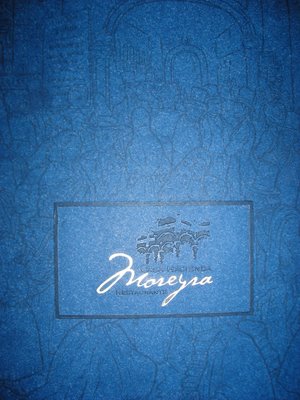 The Casa Hacienda Moreyra is an historic hacienda-style colonial house that has stood in what is now the heart of San Isidro, Lima’s most elegant district, since it was constructed in the 1700s.
The Casa Hacienda Moreyra is an historic hacienda-style colonial house that has stood in what is now the heart of San Isidro, Lima’s most elegant district, since it was constructed in the 1700s.
During the Colonial period, the Huallas region where San Isidro is located was deeded in a land grant to Nicolás de Rivera. In 1560, Antonio de Rivera, brought some olive seedlings from Spain, but only a few survived. He planted an olive grove, and over time it flourished, and became known as the Bosque del Olivar. By the 1700s,when construction began on the Casa Hacienda, there were over 2,000 olive trees in the Bosque, which today is a short walk from the Casa Hacienda. The Casa Hacienda's early owners were all members of Lima’s aristocracy. Due to its proximity to the olive groves, upon its completion, the house was initially called the Casa Hacienda El Olivar. The Count of San Isidro acquired the house in 1777. In 1853, the property passed into the hands of Gregorio Paz Soldán, and finally to its current owners, the Moreyra and Paz Soldán families.
The Casa Hacienda's early owners were all members of Lima’s aristocracy. Due to its proximity to the olive groves, upon its completion, the house was initially called the Casa Hacienda El Olivar. The Count of San Isidro acquired the house in 1777. In 1853, the property passed into the hands of Gregorio Paz Soldán, and finally to its current owners, the Moreyra and Paz Soldán families.
The Casa Hacienda Moreyra is a one-story building, built many feet off the ground so its owners could view their lands from the home’s walkways
You enter this imposing building via a large enclosed patio and garden. The moment you enter the property, you are immediately transported far from the hectic pace of central San Isidro. To enter the house itself, you climb a set of double staircases that lead to the main entryway. The chapel and the well are the oldest parts of the house. The house also has a basement and subterranean passageways.
 The Casa Hacienda Moreyra has been declared a Historic Monument. Despite earthquakes, restorations, and structural changes, the home has made it into the 21st century relatively intact and true to its original character.
The Casa Hacienda Moreyra has been declared a Historic Monument. Despite earthquakes, restorations, and structural changes, the home has made it into the 21st century relatively intact and true to its original character.
In construction from the 1700s through the early 1800s, it has a variety of architectural elements. There are baroque ornamental features from the Colonial period such as the chapel façade, the carefully detailed window moldings, the elegant carved doors, and the semi-circular archways. There are later neo-Classical touches added to the main building after Peruvian Independence in 1821, and known as Republican style.
Strolling along the walkways, balconies, past the observation tower, and through the spacious and well-appointed rooms, you are transported to another era. The height of the walls provide a sense of space and the open doorways create a free flow of movement from one part of the house to another.
The garden, which completely surrounds the house, is always visible from its windows and creates a feeling of being both indoors and outdoors at the same time. The colored walls, the majestic hand carved doors, and the elegant furnishing, including period antiques, mirrors, and paintings on loan from Peru’s National Institute of Culture, have breathed new life to the Casa Hacienda in its current reincarnation as an elegant restaurant run by the Puga family.
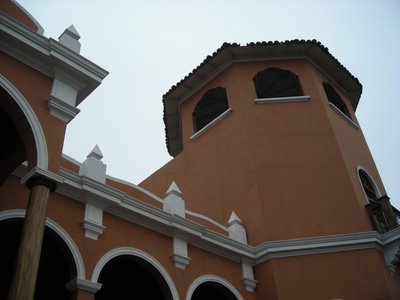 We were told the Counts of San Isidro would climb the tower, from which they could see as far away as the port of El Callao, as well as the towers of the Cathedral, in Central Lima.
We were told the Counts of San Isidro would climb the tower, from which they could see as far away as the port of El Callao, as well as the towers of the Cathedral, in Central Lima.
There are five distinct dining areas. The more casual outdoor walkway where you dine alfresco, the inviting yellow room, and the very elegant blue and red rooms. There is also an outdoor patio used for special gatherings. While dining, a pianist plays Peruvian waltzes, jazz, and classical pieces on an antique piano.
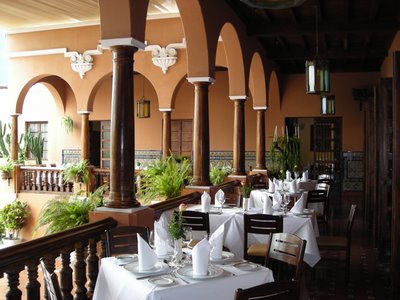 One of the items on the menu that caught my eye was the Argentine prime rib, which is served daily for lunch. The meat is smoked with huarango wood chips from Ica. Then, it is seared quickly at intense heat, and cooked at a low temperature to retain the juices. Before cooking, the prime rib is seasoned with salt from Maras (near Cuzco) and marinated in olive oil.
One of the items on the menu that caught my eye was the Argentine prime rib, which is served daily for lunch. The meat is smoked with huarango wood chips from Ica. Then, it is seared quickly at intense heat, and cooked at a low temperature to retain the juices. Before cooking, the prime rib is seasoned with salt from Maras (near Cuzco) and marinated in olive oil.
We saw this cut being presented with a flourish at tableside, served with an herbal potato au gratin, a red wine reduction, and two sauces: coarse mustard and horseradish. The prime rib is best accompanied by a Malbec.
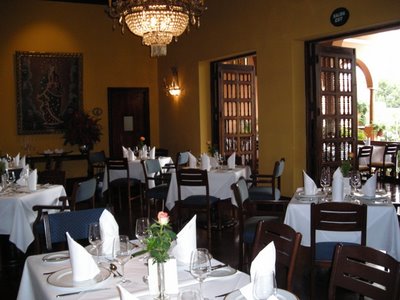 There are many historical anecdotes associated with the Casa Hacienda Moreyra.
There are many historical anecdotes associated with the Casa Hacienda Moreyra.
One of these involves one of the grande dames of Lima's Viceregal aristocracy, Doña Rosa Gutierrez de Cossío, the Countess of San Isidro, who offered the liberator of Peru, José de San Martín, a reception in the Casa Hacienda.
 The celiling in the Casa Hacienda's bar, where we spent most of our visit, is decorated with hand-painted angels. Unfortunately, we did not get a chance to eat at the Casa Hacienda on this trip to Lima. We had stopped by to take an aperitif prior to heading to a different restaurant for lunch. Once there, we regretted having made reservations elsewhere, but since we were meeting people, we couldn’t stay and sample the cuisine.
The celiling in the Casa Hacienda's bar, where we spent most of our visit, is decorated with hand-painted angels. Unfortunately, we did not get a chance to eat at the Casa Hacienda on this trip to Lima. We had stopped by to take an aperitif prior to heading to a different restaurant for lunch. Once there, we regretted having made reservations elsewhere, but since we were meeting people, we couldn’t stay and sample the cuisine.


 Upon return from Lima, I have heard mixed reports about the quality of the food. Others who have dined there say that although the food is good, for the price there are better options in Lima. Still, I would return to the Casa Hacienda for a meal the next time in Peru. The atmosphere alone is worth a visit.
Upon return from Lima, I have heard mixed reports about the quality of the food. Others who have dined there say that although the food is good, for the price there are better options in Lima. Still, I would return to the Casa Hacienda for a meal the next time in Peru. The atmosphere alone is worth a visit. I must say, the cóctel de algarrobina we had there was superb and potent, and the service we received was impeccable. Kudos to the hostess who was gracious enough to give us a tour of the Casa Hacienda and fill us in on all the historical details.Casa Hacienda Moreyra
I must say, the cóctel de algarrobina we had there was superb and potent, and the service we received was impeccable. Kudos to the hostess who was gracious enough to give us a tour of the Casa Hacienda and fill us in on all the historical details.Casa Hacienda Moreyra
Avenida Paz Soldán 290, San Isidro
444-3979, 444-4022
Website: Casa Hacienda Moreyra
Peru.Food@gmail.com
.
.
.
For a while now, many people have suggested I place ads on this blog. Longtime readers will recall this blog started as a hobby of mine; and as such, I have been reticent to make it commercial in any way. However, it is time-consuming to manage a blog like this, and we can all use a little extra cash sent our way. So, as of today, I have decided to try out Ads by Google on an experimental basis. Part of me doesn't like the way the ads look, but another part of me is curious to discover if I might actually make a little money from this blog. I am interested in hearing your opinions on placing ads on a blog such as this one. Like I said, I am going to go ahead and place these ads to see what happens. I may decide to keep them, or take them down, but your comments are certainly welcome.
Peru.Food@gmail.com
.
.
.
 I'm back! It's just been a bit crazy around work these past few weeks (if you knew my job, I'm sure you'd understand...) but that's neither here nor there. The important thing is I am back to blogging about Peruvian food and there are some interesting items to mention (thank you to all who wrote me during my hiatus, gracias por escribirme mientras estaba ocupado en otras cosas...)
I'm back! It's just been a bit crazy around work these past few weeks (if you knew my job, I'm sure you'd understand...) but that's neither here nor there. The important thing is I am back to blogging about Peruvian food and there are some interesting items to mention (thank you to all who wrote me during my hiatus, gracias por escribirme mientras estaba ocupado en otras cosas...)
The March issue of Saveur magazine as well as the May issue of Food & Wine both mentioned Peruvian cuisine.
 First, Food & Wine published its annual Go List, which names the top restaurants to visit worldwide. In the South America and Mexico category, Peru was one of four locations listed. Lima's top picks included El Kapallaq and the venerable Astrid & Gaston. If you check the fine print, you may find yours truly mentioned as well as another friendly collaborator, María Elena Cornejo.
First, Food & Wine published its annual Go List, which names the top restaurants to visit worldwide. In the South America and Mexico category, Peru was one of four locations listed. Lima's top picks included El Kapallaq and the venerable Astrid & Gaston. If you check the fine print, you may find yours truly mentioned as well as another friendly collaborator, María Elena Cornejo.
 Saveur had a great article in March by Maricel E. Presilla, with photos by Penny de los Santos, about Northern Peruvian cuisine.
Saveur had a great article in March by Maricel E. Presilla, with photos by Penny de los Santos, about Northern Peruvian cuisine.
 I loved the photos in Saveur (which I have since photographed) including this one above of a fresh ceviche.
I loved the photos in Saveur (which I have since photographed) including this one above of a fresh ceviche.
 This quartet of images is so perfectly coastal Peruvian they defy definition.
This quartet of images is so perfectly coastal Peruvian they defy definition.
 Above is an excellent portrait of an old man wearing the traditional hat of Northern Peru.
Above is an excellent portrait of an old man wearing the traditional hat of Northern Peru.
 Hot peppers have been cultivated along Peru's coast for millenia, as the photo above attests.
Hot peppers have been cultivated along Peru's coast for millenia, as the photo above attests.
 A Peruvian hand reaches into a basket of produce, ready to create yet another wonderful Peruvian dish.
A Peruvian hand reaches into a basket of produce, ready to create yet another wonderful Peruvian dish.
 Sunset over the Pacific, Peruvian style.
Sunset over the Pacific, Peruvian style.
Peru.Food@gmail.com
.
.
.







